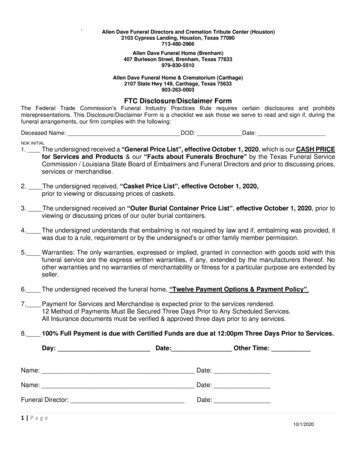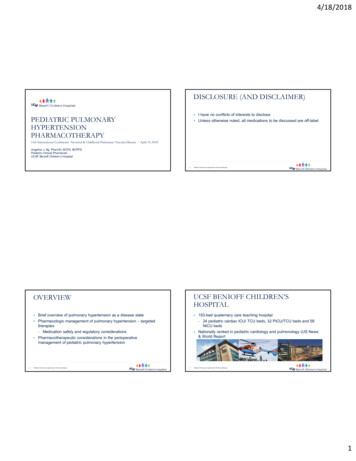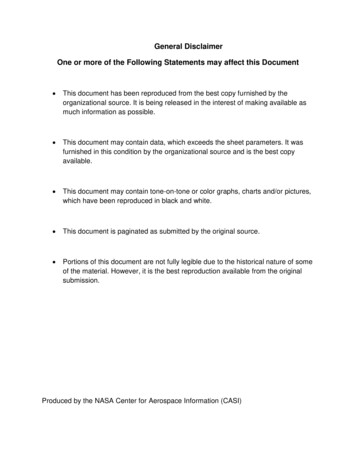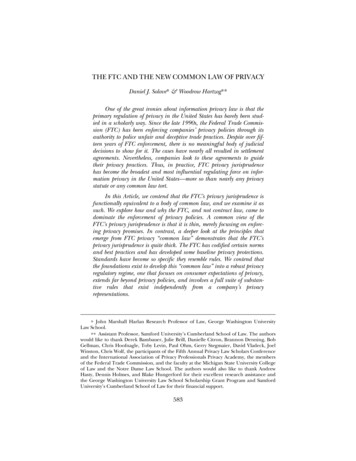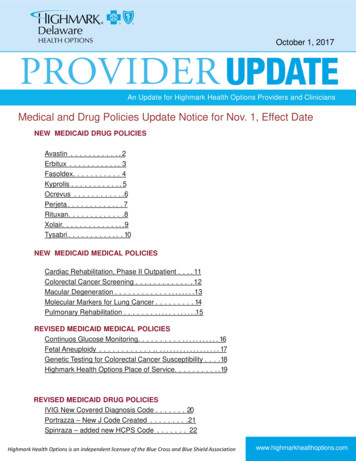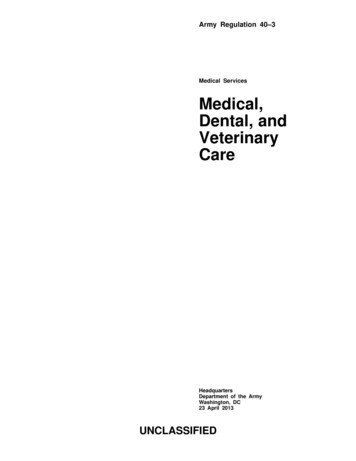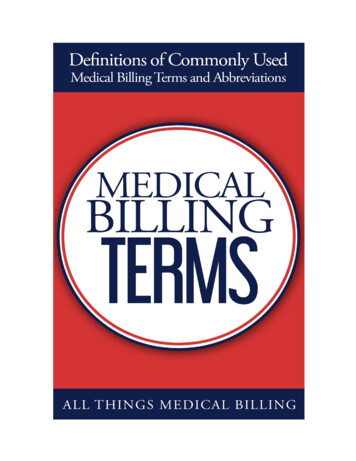
Transcription
Disclaimer and FTC NoticeThis publication may not be reproduced or transmitted in any form or by any means, mechanicalor electronic, including photocopying or recording, or by any information storage and retrievalsystem, or transmitted by email without the written permission from the publisher.This publication is for entertainment purposes only. The author does not assume anyresponsibility for any opinions, omissions, errors, or interpretations of the publication subjectmatter. The author has made every attempt to verify the information contained in this publication.The content of this publication should not be taken as expert instruction and is only the views ofthe author. The reader of this publication is responsible for his or her own actions.This book may include references to products, services, and information by third parties and maycontain materials and opinions expressed by their owners. The author does not assume anyliability or responsibility for third party opinions or materials.Users of this publication are advised to do their own research and due diligence with regard to allproducts, information, or services listed. By reading this publication you agree the author is notresponsible for the success or failure of any business venture. Nor does the author guarantee anyearnings or business success related to the use of the third party products, services, orinformation listed.The reader or purchaser of this book is responsible for adhering to all applicable federal, state,local, and international laws and regulations, including those governing professional licensing,business practices, advertising, and all other aspects of doing business in the US, Canada, orany other jurisdiction.This publication may contain affiliate links in the content which would result in a sales commisionfor the author should you decide to purchase a product or service mentioned herein. Any affiliateswill be fully disclosed. However only affiliate links are used for services or products that are usedby the author. Please research before making online purchases.The views expressed are those of the author alone, and should not be taken as expert instructionor commands. The reader is responsible for his or her own actions. The author does not assumeany responsibility or liability whatsoever on the behalf of the purchaser or reader of thispublication. Any perceived slight of any individual or organization is not intentional.Online Training at MedicalBillingStudyCourse.comHelpful Books at All-Things-Medical-Billing.comMedical Billing Software at Software AdviceCopyright 2017All-Things-Medical-Billing.com
AMA - American Medical Association. The AMA is the largest association ofdoctors in the United States. They publish the Journal of American MedicalAssociation which is one of the most widely circulated medical journals in theworld.Aging - One of the medical billing terms referring to the unpaid insurance claimsor patient balances that are due past 30 days. Most medical billing software'shave the ability to generate a separate report for insurance aging and patientaging. These reports typically list balances by 30, 60, 90, and 120 dayincrements.Ancillary Services - These are typically services a patient requires in a hospitalsetting that are in addition to room and board accommodations - such as surgery,tests, counseling, therapy, etc.Appeal - When an insurance plan does not pay for treatment, an appeal (eitherby the provider or patient) is the process of objecting this decision. The insurermay require documentation when processing an appeal and typically has aformal policy or process established for submitting an appeal. Many times theprocess and associated forms can be found on the insurance providers web site.Applied to Deductible - You typically see these medical billing terms on thepatient statement. This is the amount of the charges, determined by the patientsinsurance plan, the patient owes the provider. Many plans have a maximumannual deductible that once met is then covered by the insurance provider.Assignment of Benefits - Insurance payments that are paid to the doctor orhospital for a patient's treatment.ASP - Application Service Provider. This is a computer based services over anetwork for a particular application. Sometimes referred to as SaaS (Software asa Service). There application service providers that offer Medical Billing. Theappeal of an ASP is it frees a business of the the need to purchase, maintain,and backup software and servers.Beneficiary - Person or persons covered by the health insurance plan.Blue Cross Blue Shield (BCBS) - An organization of affiliated insurancecompanies (approximately 450), independent of the association (and each other),that offer insurance plans within local regions under one or both of theassociation's brands (Blue Cross or Blue Shield). Many local BCBS associationsare nonprofit BCBS sometimes acts as administrators of Medicare in many statesor regions.Capitation - A fixed payment paid per patient enrolled over a defined period ofCopyright 2017All-Things-Medical-Billing.com
time, paid to a health plan or provider. This covers the costs associated with thepatient's health care services. This payment is not affected by the type or numberof services provided.CHAMPUS - Civilian Health and Medical Program of the Uniformed Services.Recently renamed TRICARE. This is federal health insurance for active dutymilitary, National Guard and Reserve, retirees, their families, and survivors.Charity Care - When medical care is provided at no cost or at reduced cost to apatient that cannot afford to pay.Clean Claim - Medical billing term for a complete submitted insurance claim thathas all the necessary correct information without any omissions or mistakes thatallows it to be processed and paid promptly.Clearinghouse - This is a service that transmits claims to insurance carriers.Prior to submitting claims the clearinghouse scrubs claims and checks for errors.This minimizes the amount of rejected claims as most errors can be easilycorrected. Clearinghouses electronically transmit claim information that iscompliant with the strict HIPAA standards (this is one of the medical billing termswe see a lot more of lately).CMS - Centers for Medicaid and Medicare Services. Federal agency whichadministers Medicare, Medicaid, HIPAA, and other health programs. Formerlyknown as the HCFA (Health Care Financing Administration). You'll notice thatCMS it the source of a lot of medical billing terms.CMS 1500 - Medical claim form established by CMS to submit paper claims toMedicare and Medicaid. Most commercial insurance carriers also require paperclaims be submitted on CMS-1500's. The form is distinguished by it's red ink.Coding - Medical Billing Coding involves taking the doctor's notes from a patientvisit and translating them into the proper ICD-9 code for diagnosis and CPTcodes for treatment.COBRA Insurance - This is health insurance coverage available to an individualand their dependents after becoming unemployed - either voluntary orinvoluntary termination of employment for reasons other than gross misconduct.Because it does not typically receive company matching, It's typically moreexpensive than insurance the cost when employed but does benefit from thesavings of being part of a group plan. Employers must extend COBRA coverageto employees dismissed for a. COBRA stands for Consolidated Omnibus BudgetReconciliation Act which was passed by Congress in 1986.COBRA coverage typically lasts up to 18 months after becoming unemployedCopyright 2017All-Things-Medical-Billing.com
and under certain conditions extend up to 36 months.Coinsurance - Percentage or amount defined in the insurance plan for which thepatient is responsible. Most plans have a ratio of 90/10 or 80/20, 70/30, etc. Forexample the insurance carrier pays 80% and the patient pays 20%.Collection Ratio - This is in reference to the providers accounts receivable. It'sthe ratio of the payments received to the total amount of money owed on theprovider's accounts.Contractual Adjustment - The amount of charges a provider or hospital agreesto write off and not charge the patient per the contract terms with the insurancecompany.Coordination of Benefits - When a patient is covered by more than oneinsurance plan. One insurance carrier is designated as the primary carrier andthe other as secondary.Co-Pay - Amount paid by patient at each visit as defined by the insured plan.CPT Code - Current Procedural Terminology. This is a 5 digit code assigned forreporting a procedure performed by the physician. The CPT has a correspondingICD-9 diagnosis code. Established by the American Medical Association. This isone of the medical billing terms we use a lot.Credentialing - This is an application process for a provider to participate withan insurance carrier. Many carriers now request credentialing through CAQH.CAQH credentialing process is a universal system now accepted by insurancecompany networks.Credit Balance - The balance that's shown in the "Balance" or "Amount Due"column of your account statement with a minus sign after the amount (forexample 50-). It may also be shown in parenthesis; ( 50). The provider mayowe the patient a refund.Crossover claim - When claim information is automatically sent from Medicarethe secondary insurance such as Medicaid.Date of Service (DOS) - Date that health care services were provided.Day Sheet - Summary of daily patient treatments, charges, and paymentsreceived.Deductible - amount patient must pay before insurance coverage begins. Forexample, a patient could have a 1000 deductible per year before their healthCopyright 2017All-Things-Medical-Billing.com
insurance will begin paying. This could take several doctor's visits orprescriptions to reach the deductible.Demographics - Physical characteristics of a patient such as age, sex, address,etc. necessary for filing a claim.DME - Durable Medical Equipment - Medical supplies such as wheelchairs,oxygen, catheter, glucose monitors, crutches, walkers, etc.DOB - Abbreviation for Date of BirthDowncoding - When the insurance company reduces the code (andcorresponding amount) of a claim when there is no documentation to support thelevel of service submitted by the provider. The insurers computer processingsystem converts the code submitted down to the closest code in use whichusually reduces the payment.Duplicate Coverage Inquiry (DCI) - Request by an insurance company or groupmedical plan by another insurance company or medical plan to determine if othercoverage exists.Dx - Abbreviation for diagnosis code (ICD-9 or ICD-10 code).Electronic Claim - Claim information is sent electronically from the billingsoftware to the clearinghouse or directly to the insurance carrier. The claim filemust be in a standard electronic format as defined by the receiver.Electronic Funds Transfer (EFT) - An electronic paperless means oftransferring money. This allows funds to be transferred, credited, or debited to abank account and eliminates the need for paper checks.E/M - Evaluation and Management section of the CPT codes. These are the CPTcodes 99201 thru 99499 most used by physicians to access (or evaluate) apatient's treatment needs.EMR - Electronic Medical Records. This is a medical record in digital format of apatient's hospital or provider treatment.Enrollee - Individual covered by health insurance.EOB - Explanation of Benefits. One of the medical billing terms for the statementthat comes with the insurance company payment to the provider explainingpayment details, covered charges, write offs, and patient responsibilities anddeductibles.Copyright 2017All-Things-Medical-Billing.com
ERA - Electronic Remittance Advice. This is an electronic version of aninsurance EOB that provides details of insurance claim payments. These areformatted in according to the HIPAA X12N 835 standard.ERISA - Employee Retirement Income Security Act of 1974. This law establishedthe reporting, disclosure of grievances, and appeals requirements and financialstandards for group life and health. Self-insured plans are regulated by this law.Fee For Service - Insurance where the provider is paid for each service orprocedure provided. Typically allows patient to choose provider and hospital.Some policies require the patient to pay provider directly for services and submita claim to the carrier for reimbursement. The trade-off for this flexibility is usuallyhigher deductibles and co-pays.Fee Schedule - Cost associated with each treatment CPT medical billing codes.Financial Responsibility - The portion of the charges that are the responsibilityof the patient or insured.Fiscal Intermediary (FI) - A Medicare representative who processes Medicareclaims.Formulary - A list of prescription drug costs which an insurance company willprovide reimbursement for.Fraud - When a provider receives payment or a patient obtains services bydeliberate, dishonest, or misleading means.GPH - Group Health Plan. A means for one or more employer who provide healthbenefits or medical care for their employees (or former employees).Group Name - Name of the group or insurance plan that insures the patient.Group Number - Number assigned by insurance company to identify the groupunder which a patient is insured.Guarantor - A responsible party and/or insured party who is not a patient.HCFA - Health Care Financing Administration. Now know as CMS (see above inMedical Billing Terms).HCPCS - Health Care Financing Administration Common Procedure CodingSystem. (pronounced "hick-picks"). Three level system of codes. CPT is Level I.A standardized medical coding system used to describe specific items orservices provided when delivering health services. May also be referred to as aCopyright 2017All-Things-Medical-Billing.com
procedure code in the medical billing glossary.The three HCPCS levels are:Level I - American
Applied to Deductible - You typically see these medical billing terms on the patient statement. This is the amount of the charges, determined by the patients insurance plan, the patient owes the provider. Many plans have a maximum annual deductible that once met is then covered by the insurance provider.
